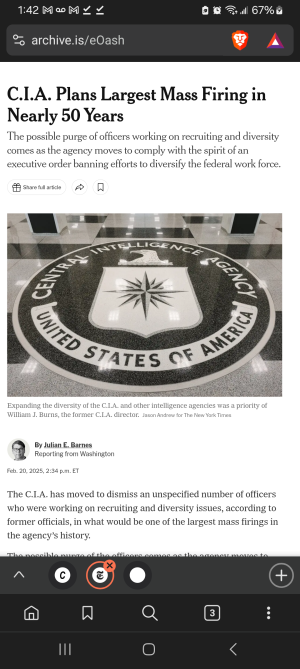We need a full accounting! The silence as they continue to push is very concerning to me. Very! Skol!I'm doing that exactly now. My folks were great health wise at 76. Took the jab. Nothing but problems for both since.
-
Pat Flood (@rebarcock) passed away 9/21/25. Pat played a huge role in encouraging the devolopmemt of this site and donated the very first dollar to get it started. Check the thread at the top of the board for the obituary and please feel free to pay your respects there. I am going to get all the content from that thread over to his family so they can see how many people really cared for Pat outside of what they ever knew. Pat loved to tell stories and always wanted everyone else to tell stories. I think a great way we can honor Pat is to tell a story in his thread (also pinned at the top of the board).
You are using an out of date browser. It may not display this or other websites correctly.
You should upgrade or use an alternative browser.
You should upgrade or use an alternative browser.
Master Thread Dance Your Cares Away/Fraggle/Law Abiding Citizens
- Thread starter Bryan74b
- Start date
Master Threads
Asked Grok
Is biblical prophecy reliable?
Long answer but it was affirmative.
Asked grok
Do you know about the prophecy of Pope Francis being the last pope?
, I’m familiar with the idea tied to the "Prophecy of the Popes," often attributed to Saint Malachy, a 12th-century Irish archbishop. This prophecy is a list of 112 short Latin phrases, each supposedly describing a future pope, starting with Celestine II in 1143 and ending with a figure called "Petrus Romanus" (Peter the Roman), who’s said to be the last pope before a dramatic end involving the destruction of Rome and divine judgment. Some people interpret this to suggest Pope Francis, the current pope as of February 21, 2025, might be this final figure.
Here’s the gist: Malachy allegedly had a vision in 1139 while visiting Rome, wrote down these cryptic mottos, and gave them to Pope Innocent II. The document then supposedly vanished until it was published in 1595 by a Benedictine monk named Arnold Wion in his book Lignum Vitae. Up to 1590, the descriptions match historical popes pretty well—think “Ex castro Tiberis” (from a castle on the Tiber) for Celestine II, who was born in a town by the Tiber River. After 1590, though, the phrases get vague and harder to pin down, like “Rosa Umbriae” (Rose of Umbria) for Clement XIII, who had a thin connection to Umbria.
For Pope Francis, the link to "Peter the Roman" hinges on a few stretches: his birth name is Jorge Mario Bergoglio, and his parents were Italian immigrants, tying him to Rome culturally. He chose the name Francis after St. Francis of Assisi, whose father was named Pietro (Italian for Peter). The prophecy’s final entry reads: “In the final persecution of the Holy Roman Church, there will sit Peter the Roman, who will pasture his sheep in many tribulations, and when these things are finished, the city of seven hills will be destroyed, and the dreadful judge will judge his people. The End.” Some see Francis’s focus on social issues and church reform as “pasturing sheep” amid trouble, but there’s no clear “persecution” or Roman ruin yet.
Skeptics—and most historians—call this a 16th-century forgery, likely cooked up to sway a papal election (maybe for Cardinal Simoncelli in 1590, whose hometown fit the motto “from the old city”). The accuracy drops off after 1590, and St. Bernard, Malachy’s biographer, never mentioned any prophecy. The Catholic Church doesn’t endorse it officially, and some theologians dismiss it outright.
Biblically, this connects loosely to end-times ideas—like Revelation 17’s fall of Babylon, often linked to Rome—but it’s not a direct match. The Antichrist or False Prophet (Revelation 19:20) theories float around, but nothing in Scripture names a last pope. So, is Francis the final one? The prophecy’s murky origins and forced interpretations leave it shaky. It’s more of a historical curiosity than a biblical slam dunk. What do you think about it?
Ask anything
Is biblical prophecy reliable?
Long answer but it was affirmative.
Asked grok
Do you know about the prophecy of Pope Francis being the last pope?
, I’m familiar with the idea tied to the "Prophecy of the Popes," often attributed to Saint Malachy, a 12th-century Irish archbishop. This prophecy is a list of 112 short Latin phrases, each supposedly describing a future pope, starting with Celestine II in 1143 and ending with a figure called "Petrus Romanus" (Peter the Roman), who’s said to be the last pope before a dramatic end involving the destruction of Rome and divine judgment. Some people interpret this to suggest Pope Francis, the current pope as of February 21, 2025, might be this final figure.
Here’s the gist: Malachy allegedly had a vision in 1139 while visiting Rome, wrote down these cryptic mottos, and gave them to Pope Innocent II. The document then supposedly vanished until it was published in 1595 by a Benedictine monk named Arnold Wion in his book Lignum Vitae. Up to 1590, the descriptions match historical popes pretty well—think “Ex castro Tiberis” (from a castle on the Tiber) for Celestine II, who was born in a town by the Tiber River. After 1590, though, the phrases get vague and harder to pin down, like “Rosa Umbriae” (Rose of Umbria) for Clement XIII, who had a thin connection to Umbria.
For Pope Francis, the link to "Peter the Roman" hinges on a few stretches: his birth name is Jorge Mario Bergoglio, and his parents were Italian immigrants, tying him to Rome culturally. He chose the name Francis after St. Francis of Assisi, whose father was named Pietro (Italian for Peter). The prophecy’s final entry reads: “In the final persecution of the Holy Roman Church, there will sit Peter the Roman, who will pasture his sheep in many tribulations, and when these things are finished, the city of seven hills will be destroyed, and the dreadful judge will judge his people. The End.” Some see Francis’s focus on social issues and church reform as “pasturing sheep” amid trouble, but there’s no clear “persecution” or Roman ruin yet.
Skeptics—and most historians—call this a 16th-century forgery, likely cooked up to sway a papal election (maybe for Cardinal Simoncelli in 1590, whose hometown fit the motto “from the old city”). The accuracy drops off after 1590, and St. Bernard, Malachy’s biographer, never mentioned any prophecy. The Catholic Church doesn’t endorse it officially, and some theologians dismiss it outright.
Biblically, this connects loosely to end-times ideas—like Revelation 17’s fall of Babylon, often linked to Rome—but it’s not a direct match. The Antichrist or False Prophet (Revelation 19:20) theories float around, but nothing in Scripture names a last pope. So, is Francis the final one? The prophecy’s murky origins and forced interpretations leave it shaky. It’s more of a historical curiosity than a biblical slam dunk. What do you think about it?
Ask anything
I can't wait to find out
No federal money for Maine. They still allow transgenders to play sports in wrong gender

 www.foxnews.com
www.foxnews.com

Trump vows to cut off federal funding to Maine over refusal to comply with 'No Men in Women's Sports' order
President Donald Trump announced he will cut off federal funding to Maine if it continues to defy his executive order keeping trans athletes out of women's sports.
I hope GITMO is a half-way staging point to get these people back to their home countries. Move them in and out quickly but save a portion for permanent yet to be named residents.

Trump says he's 'sick' of how Zelenskyy has handled Ukraine's war with Russia: 'He has no cards'
"I don’t think he’s very important to be at meetings, to be honest with you," Trump said days after Zelenskyy said Ukraine was not invited to peace talks with the U.S. and Russia.
Part Deux

 www.dailymail.co.uk
www.dailymail.co.uk

New coronavirus with pandemic potential discovered by Wuhan scientists
A team led by virologist Shi Zhengli, known as 'Batwoman' for her work on coronaviruses, detected a new virus, HKU5-CoV-2, in bats in China.
Stop killing the birds assholes.... LOL
In Colombia I got farm-fresh/organic eggs at the Farmer's Market - 3 dozen for $20,000 COP or $5.00 USD
Chic7ken farmer telling the truth
Hopefully no longer holding a scalpel
Unless he's slicing his own neck.
Declare the war over. Let them go to Ukraine but they have to leave their wealth here or transfer it here. Then tell Putin he can have all of Ukraine as long as the US gets a portion of the rare earth minerals.
Good video. Seen it beforre
ShaolinNole
Legendary
I know what stock I'm shorting today.
Detroit or Baltimore?
AgEngDawg
Legendary
Sometimes two alphas get at odds, but they always smooth things out in the end.
Alphas respect each other in the end.
The Big Dogs are back together!
AgEngDawg
Legendary
Learn to code.
Maybe that is a dude, but the voice has been doctored.
Similar threads
- Replies
- 13
- Views
- 450
- Replies
- 0
- Views
- 2K
- Replies
- 56
- Views
- 4K
- Replies
- 113
- Views
- 9K










